History of Asbury United Methodist Church
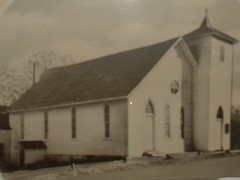
Asbury was built on the hill of Stuart Street in Christiansburg, Virginia around 1876. It was a fine example of traditional vernacular and Gothic Revival architecture, and it is beautifully portrayed in the old pictures of the church with two entrances in the front.
Originally, two doors represented one door to be used for the men and the other for the women. While this practice of seating the men and women separately may seem odd, it was church law for the first 100 years of Methodism in America. It is not known whether this practice was used at Asbury. The chimney in the rear stood tall and thin and was once connected to a “pot belly” stove located in the middle of the sanctuary.
In the Deed Book at the Montgomery County Clerk’s office, you will find recorded on September 10, 1889, George Washington and his wife Fannie deeding the lot next door to Thomas James, Philip Carter, Sampson Gleaves, Sterbert Thompson, Floyd Alexander, Jaro Nowlin, Taylor McNorton, John Morgan and Siah Richardson, Trustees of the Methodist Episcopal Church in the United States of America. The record states that the cost of the property was $35.00.
The name “Asbury” was taken from that of Bishop Francis Asbury, who in 1771 was the first American Methodist Bishop sent over from England by John Wesley to supervise the growth of the Methodist Church. The church was originally known as Asbury Chapel Methodist Episcopal Church, and the street between the two churches relates to the name of the church. At some point, the name Chapel was dropped from usage in the church name. The establishment of the Asbury family further led to the establishment of Mt Olive and later New Mt Olive Methodist Episcopal Church located in Radford, Virginia.
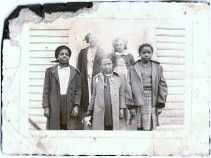
It has not yet been discovered when the name was changed to Asbury Methodist Church, however, it had to occur after the MEC South and North merger in 1939. In the days of the Central Jurisdiction, Asbury was part of a number of annual conferences. By the middle of the century, Asbury was part of the East Tennessee, the Tennessee Kentucky and the Virginia-North Carolina Annual Conferences. In the 1930’s, Asbury was located on “B” Street. Starting from the bottom of a gravel road, livestock i.e. chickens, rabbits, guineas, ducks, to the e top of the hill where you could find even a cow or two. Some of the residences included families like LaMonte and Lean Nowlin, Trigg and Clara Nowlin, John and Roberta Nowlin, Albert and Nellie Wade, and Emma Anderson.
In the late 1940’s, bathrooms and a water spigot were installed to wash down the cement floor. In 1947, the church’s monthly expenditure account was: Water Bill $1.00; Light Bill $5.00, Musician and Custodian were paid $5.00 per month; Pastor’s salary $30.00 per month; quarterly apportionments $25.00, and during the winter months a load of coal was $20.00. The old church building was originally heated with a large round stove near the front center of the sanctuary. During the late 1950’s, the stove was removed and a furnace was installed. Mr. Will Morgan, a.k.a. Mr. Itty was one of the early custodians who made the fire and took out the ashes. Mr. Thompson Lester assumed the role later followed by Mr. Odell Palmer. The coal furnace was converted to gas around 1960. Mrs. Lena Nowlin made the bread and wine for communion and she washed and starched the linens draped around the altar to celebrate Communion Sunday (1st Sunday of the month).
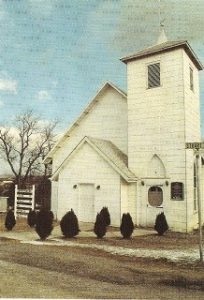
Mr. Walter A. Price, Jr. secured a contractor to install an air conditioning system and a gas furnace in the 1970’s.
Piecing together the history of Asbury United Methodist Church is difficult because the history is scattered among so many people. Early records and verbal knowledge date back to 1875, or around the time when the church was being built in 1876. Asbury UMC has been renovated several times to accommodate the growth and needs of the community. Asbury has provided the mentorship for persons who found their calling to the ministry – Rev. James A. Bishop, Rev. Patricia A. Jones, and Rev. Larry Jacobs are to just list a few.
The merger of the United Methodist Church began in 1968 when the union of the Methodist Church and the Evangelical United Brethren Church was finalized.
Rev. Lee Suggs, pastor of Schaeffer Memorial Baptist Church, preached the last Easter Sunrise service in the old church building on March 30, 1996.
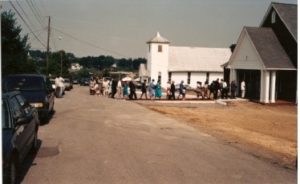
On July 27, 1997, the last service was held in the old sanctuary at 490 Stuart Street, N.E. in Christiansburg, Virginia. It was a very special day in the life of Asbury Methodist Church and because of farewell sentiments, the worship service reflected as well as to yet another milestone in the growth of the church. It was a reflection where the community celebrated life with weddings, baptisms, Sunday worship, and a final place to mourn the death of our loved ones. Statements about the meaning of the building were given by Lay Leader N. L. Bishop, Mr. Walter Price, Jr, Administration Council; Jermaine Rogers, Youth; Senior Member, Ed Jones; newest member, Dr. Randy Grayson Mrs. Carrie Mae Price, United Methodist Women. Others who gave testimonies and memoirs of the past were Mrs. Amelia Foster; and Mr. Walter A. Price III.
The “Ground Breaking” ceremony was held on Sunday, October 20, 1996, with District Superintendent Dr. Richard L. Worden and his wife……..present along with Mr. Wayne Booth, the vice-Mayor of Christiansburg. Mrs. Elizabeth Lester and Mrs. Evie James were the church’s senior members present while Ms. Jalin Diggs was the youngest person to turn over a spade of ground.
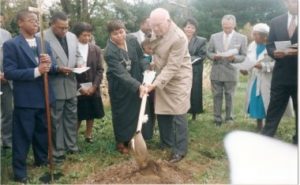
The bell from the steeple was removed from the first building on April 2, 1997. a crane was used to place the bell in the new building on July 25th. The United Methodist Men moved the piano and organ from the old to the new sanctuary on August 2, 1997.
The “First Worship Service” started from the old church, bringing the altar furnishings, and the choir leading the congregation with the processional hymn “We’re Marching to Zion”.
